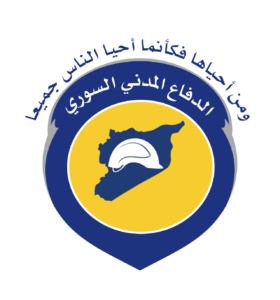![]()

Logo of Syrian Civil Defence, also known as the White Helmets
Over 50 bombs and mortars are dropped each day in Syria, each one destroying communities and leaving people homeless. Each time this happens, the White Helmets rush in to help people regardless of their religion or political views.
The White Helmets, also referred to as the Syrian Civil Defense, is a group of volunteers who are dedicated to rescuing people who have been hit by bombs or air strikes in Syria. They derive their name from the white helmets they wear while on duty.
“I first heard about the White Helmets when they were nominated for the Nobel Peace Prize. Their work to rescue people on both sides of the conflict, even their enemies, is incredibly selfless and beautiful,” Gabe Marcy, senior graphic design major, said.
The White Helmets were nominated for the 2016 Nobel Peace Prize for saving people’s lives. Though they did not get the prize, an online campaign is currently going on at whitehelmets.org to raise the $1 million they could have won as prize money. According to the website, the money will be used to treat wounded volunteers and purchase rescue equipment.
Derrick Heldenbrand, sophomore photography major, attended the John Brown University study abroad trip to Jordan. While in Jordan, the students stayed approximately five to ten kilometers away from the Syrian border.
Heldenbrand heard shelling almost every day from the mountains.
“It was really interesting to be that close to it,” Heldenbrand said.
One night, he watched flashes and red rockets that were being fired only a few kilometers away.

Emergency responders clear rubble in Maaret Nouman, Idleb, in November 2014.
Marcy, who also attended the Jordan studies trip, recalls visiting Mafraq and driving past miles of tents in the Zaatari Refugee Camp, a place of shelter for Syrian refugees.
“The concreteness of the suffering was overwhelming. Before the trip, the Syrian crisis felt abstract. Now, every time I hear about the conflicts in Syria, I think about the faces, names and stories of the beautiful people we met,” Marcy said.
The Oscar nominated team behind Virunga produced a documentary titled “The White Helmets.” The documentary, which was released last month on Netflix, documents the life of the White Helmets as they rescue people in Syria.
The 2,900 volunteers have saved more than 62,000 lives. They are targeted by the government and over 141 of them have been killed.
“In what’s called a ‘double-tap,’ suspected Syrian government planes drop an initial barrel bomb at a site and then a second one after the rescuers begin to arrive,” according to Time Magazine.
According to Heldenbrand, it makes sense for The White Helmets to be targets, because they are aiding the cause that the enemy is fighting by saving the people.
The motto for the White Helmets is “to save one life, is to save all of humanity.” They are committed to the principles of humanity, solidarity and impartiality, accoriding to their website
The White Helmets received attention in 2014 when they rescued a child from the rubble. The 10-year-old child had been trapped for 16 hours until one of the White Helmets rescued him. This gained international attention and the child became known as the “miracle baby.”
Marcy would like to see more aid agencies and ordinary people supporting the White Helmets.
“Their website has a lot of ways to contribute. Items like safety goggles are under five dollars. This is a tangible way for JBU students to respond,” Marcy said. “I also think it’s important to share the stories of the White Helmets. So often, news sources portray the hellish war experiences in Syria, but fail to show that there are good people working for peace.”




